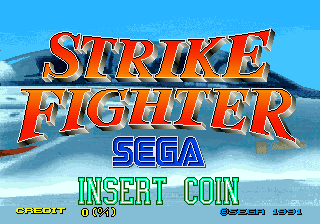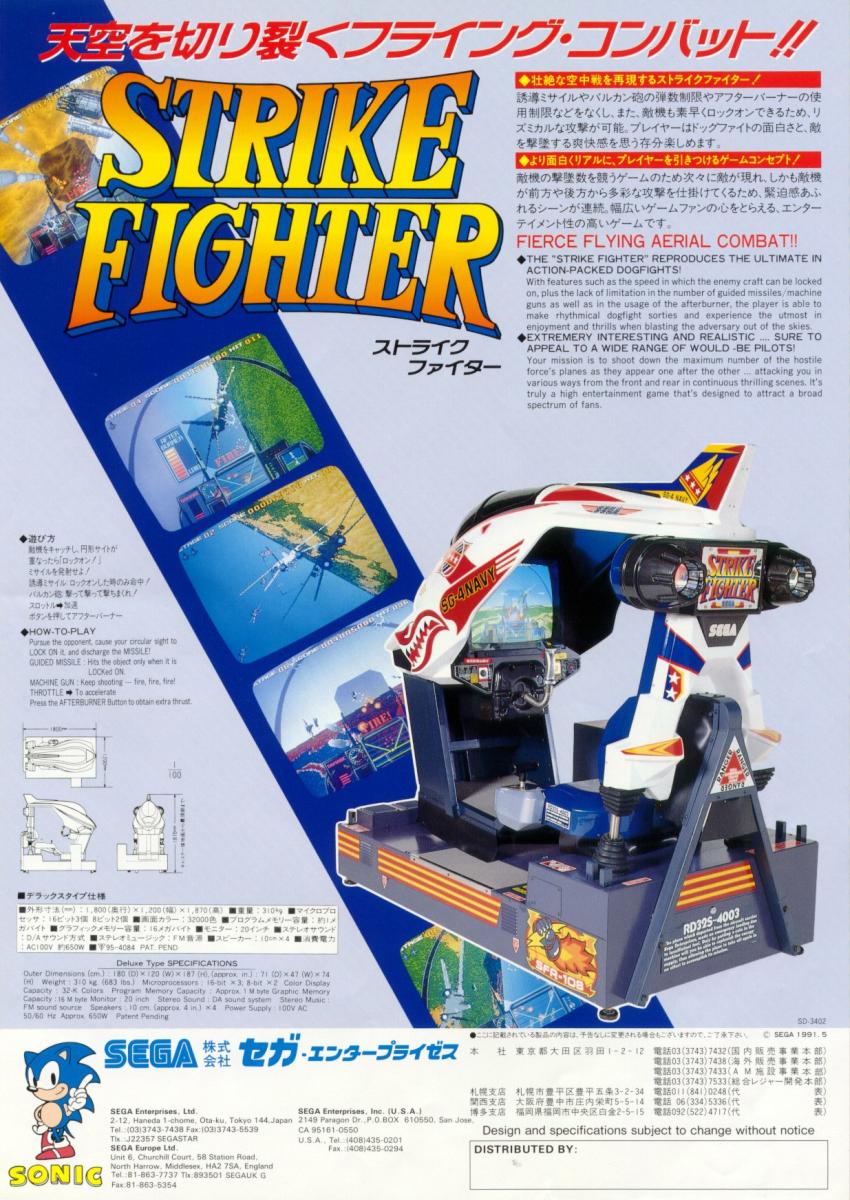Difference between revisions of "Strike Fighter"
From Sega Retro
| Line 1: | Line 1: | ||
| − | |||
{{Bob | {{Bob | ||
| bobscreen=StrikeFighter title.png | | bobscreen=StrikeFighter title.png | ||
| Line 14: | Line 13: | ||
}} | }} | ||
}} | }} | ||
| − | ''''' | + | {{sub-stub}}'''''{{PAGENAME}}''''' (ストライクファイター) is an arcade game released for [[Sega Y Board]] hardware in 1991. It is a sequel to ''[[G-LOC: Air Battle]]'', which itself is now seen as a spin-off of the ''[[:Category:After Burner|After Burner]]'' franchise. |
| + | ==Gameplay== | ||
''Strike Fighter'', like ''G-LOC'' primarily takes place from a cockpit view, where the player is tasked with shooting down enemy planes (while making sure not to be shot down themselves). Also like ''G-LOC'', the game pans out to a third-person perspective if an enemy is on your tail. The major difference between the two is that whereas ''G-LOC'' uses a goal-based mission system, ''Strike Fighter''<nowiki>'</nowiki>s levels are similar in design to ''After Burner''<nowiki>'</nowiki>s, simply finishing when the player reaches a certain distance. | ''Strike Fighter'', like ''G-LOC'' primarily takes place from a cockpit view, where the player is tasked with shooting down enemy planes (while making sure not to be shot down themselves). Also like ''G-LOC'', the game pans out to a third-person perspective if an enemy is on your tail. The major difference between the two is that whereas ''G-LOC'' uses a goal-based mission system, ''Strike Fighter''<nowiki>'</nowiki>s levels are similar in design to ''After Burner''<nowiki>'</nowiki>s, simply finishing when the player reaches a certain distance. | ||
| + | ==Versions== | ||
''Strike Fighter'' saw most of its content re-branded as ''[[After Burner III]]'' for the [[Sega Mega-CD]]. The main difference between the two from a gameplay perspective is that ''After Burner III'' always gives users the option of playing from a third-person perspective. ''Strike Fighter'' on its own has not been ported to any home consoles. | ''Strike Fighter'' saw most of its content re-branded as ''[[After Burner III]]'' for the [[Sega Mega-CD]]. The main difference between the two from a gameplay perspective is that ''After Burner III'' always gives users the option of playing from a third-person perspective. ''Strike Fighter'' on its own has not been ported to any home consoles. | ||
==Promotional material== | ==Promotional material== | ||
| − | + | {{gallery | |
| − | + | |{{gitem|StrikeFighter YBoard JP Flyer.jpg|JP flyer}} | |
| − | + | }} | |
| + | |||
==Physical scans== | ==Physical scans== | ||
{{ScanArcade | {{ScanArcade | ||
| Line 32: | Line 34: | ||
==References== | ==References== | ||
| − | <references /> | + | <references/> |
{{StrikeFighterOmni}} | {{StrikeFighterOmni}} | ||
{{AfterBurner}} | {{AfterBurner}} | ||
Revision as of 21:48, 13 July 2018
| Strike Fighter | |||||||||
|---|---|---|---|---|---|---|---|---|---|
| System(s): Sega Y Board | |||||||||
| Publisher: Sega | |||||||||
| Developer: Sega AM2 | |||||||||
| Genre: Shoot-'em-Up | |||||||||
| Number of players: 1 | |||||||||
|
This teeny-tiny article needs some work. You can help us by expanding it.
Strike Fighter (ストライクファイター) is an arcade game released for Sega Y Board hardware in 1991. It is a sequel to G-LOC: Air Battle, which itself is now seen as a spin-off of the After Burner franchise.
Gameplay
Strike Fighter, like G-LOC primarily takes place from a cockpit view, where the player is tasked with shooting down enemy planes (while making sure not to be shot down themselves). Also like G-LOC, the game pans out to a third-person perspective if an enemy is on your tail. The major difference between the two is that whereas G-LOC uses a goal-based mission system, Strike Fighter's levels are similar in design to After Burner's, simply finishing when the player reaches a certain distance.
Versions
Strike Fighter saw most of its content re-branded as After Burner III for the Sega Mega-CD. The main difference between the two from a gameplay perspective is that After Burner III always gives users the option of playing from a third-person perspective. Strike Fighter on its own has not been ported to any home consoles.
Promotional material
Physical scans
| Y Board, JP | ||||
|---|---|---|---|---|
References
| Strike Fighter | |
|---|---|
|
Main page | Comparisons | Credits | Magazine articles | Reception
| |



